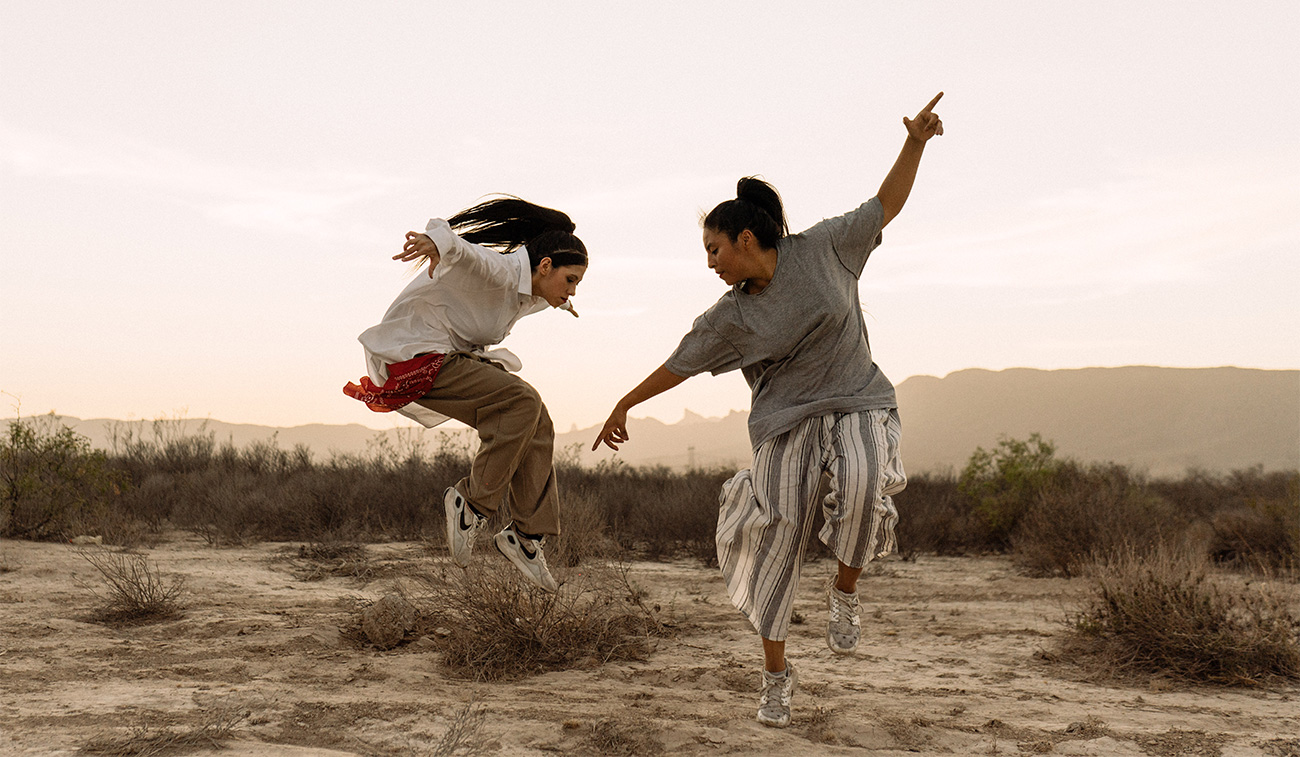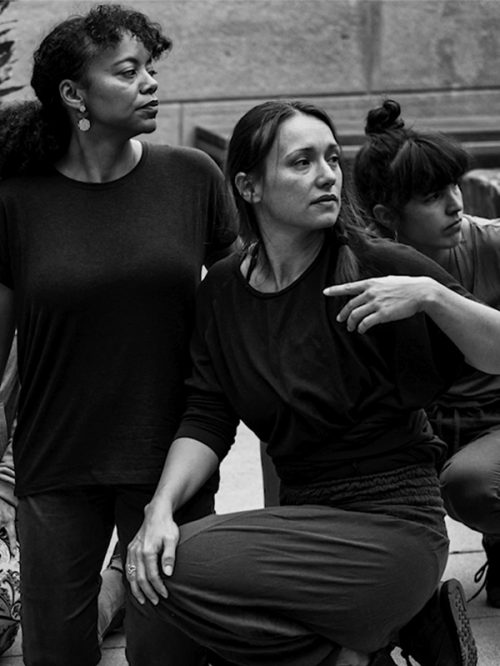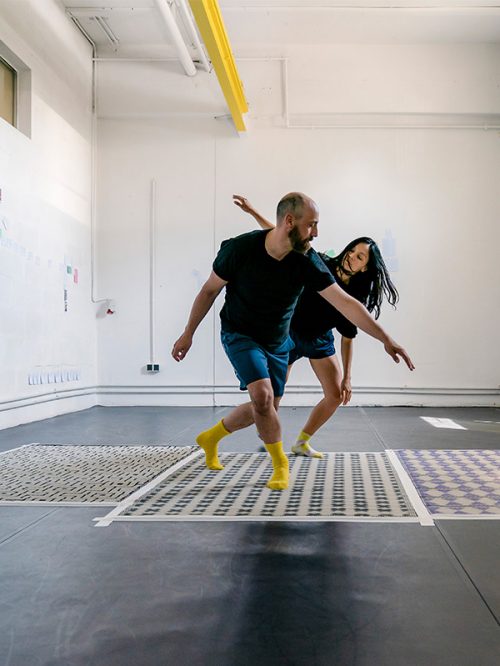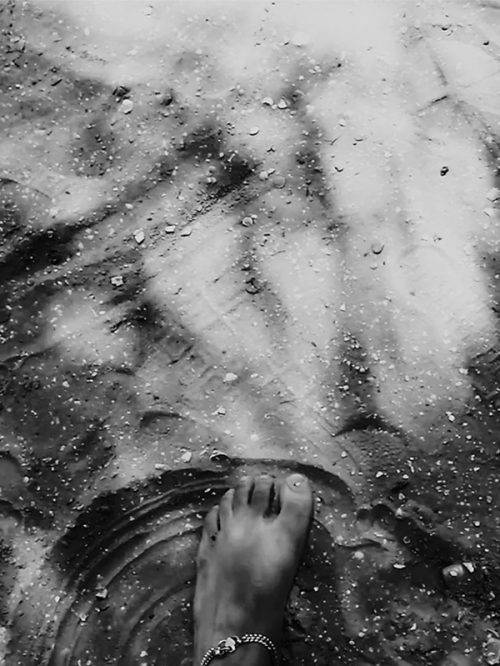My trip to the Cumbia Colombiana in Monterrey
Yo vengo con mi sombrero, con mi pañuelo amarrado…
(Con el pie pelado, Andres Landero)

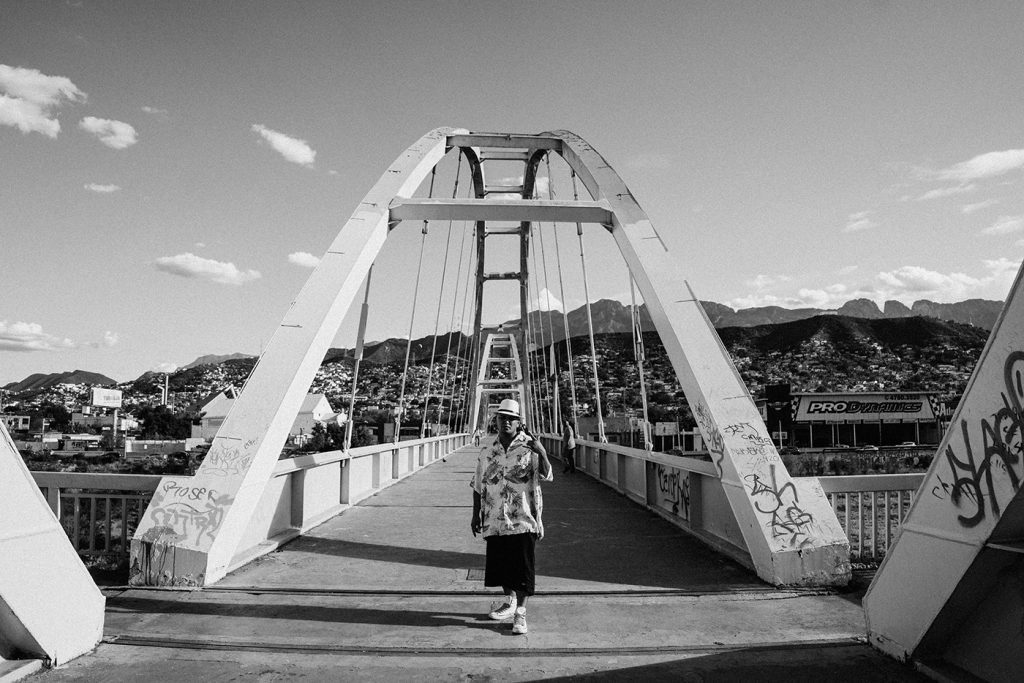
This text is written from my memories and from the memories of Monterrey artists who kindly collaborated in my research[1] on the cumbia colombiana regia, which I conducted in June 2022. In my text I quote and use some ideas of Silvia Rivera Cusicanqui, sociologist, historian and activist from La Paz, Bolivia, that have helped me to understand connections and juxtapositions in the processes of identification that I locate in cumbia colombiana regia.
I have been working as a choreographer in Hamburg since 2016, where I currently live. In my choreographic works, I deal with fictional bodies in utopian and dystopian spaces that are intertwined with current political and societal realities. This year I started to research some dances, which are appearing in the border zones, specifically from Mexico. In June 2022, I traveled to Monterrey, Mexico, for three weeks to conduct this choreographic research. Being born in Chiapas, in the south of Mexico, border space with Guatemala, I was interested in knowing other spaces of tension related to the ecological, the socio-political and identity. This border space nestled in desert landscapes and has a special aesthetic, which is the scenario where emerged since the 70s a subculture that has apparently moved in the shadow of a city where modernity and American influence grows vertically as its buildings, but once inside the city, the cumbieros are like roots that interweave horizontally sustaining a part of urban life.
The music and dance of Colombian cumbia in northern Mexico has allowed the emergence of alterable processes of identification[2] that resemble an internal engine of resistance to the neoliberal system, which is rapidly digging deep into the life of the society as well as the hills of the city. This process of identification of the inhabitants of Monterrey with those of Colombia through cumbia, I consider a pact between mestizos[3] , among the colonized, which extends and resists against the presence of the white, against the U.S.A presence and influence in the city. The African, indigenous and Spanish presence from where cumbia comes is reflected, is found and reinforced in this part of Mexico. The dancers and singers of Colombian music have subjectivities, which I consider, as Rivera Cusicanqui would say, stained, variegated[4] , impure, promiscuous[5]– Juxtaposed cultural elements and become emancipating mestizo bodies.
To get in touch again with cumbia, but a different cumbia than the one I danced as a child and as a young girl in family events, was my intention of the trip. There in the streets, in the neighborhoods I wanted to find myself dancing the Colombian cumbia regia, that I knew through the movie I´m no longer here!, which was my only reference since I had never been to Monterrey before. My interest was to reinvent a part of me that always felt a gap in identification not only geographically, but culturally by the cities of the center and north of the country.
I arrived at the Monterrey airport on Wednesday June 29th 2022. Already on the plane I was warned of the drought and lack of water that the city suffered from months ago and increased leaving thousands of people without water. From the plane they showed me the peeling hills and the dry dam. An arid environment. It didn’t take long to find out the names of the companies that steal water in Monterrey like the Cuahtemoc brewery, Coca cola, Ternium among others and I felt rage and I was ashamed to feel it just getting there.
My motivation was to take Cumbia Colombiana Regia classes, to put my body to the test, to analyze the steps and understand the dance. I also wanted to meet, talk and learn from the musicians and dancers and attend the dances. I have danced cumbia all my life, in family events and some discotheques in Mexico. However, this music and style of dance from the Cumbia Colombia from Monterrey, was becoming more and more attractive to me, as it was not some folkloric dance that the government catalogs and teaches us in schools. At the same time it was also not just tropical cumbia either: the drums, the snare, the Guacharaca, the accordion, not only sounded different but it looked completely different. This was a cumbia where the movements of my feet are filled with complexity, where the speed and intensity of the steps contrast with the floating and calmness with which the torso is placed. It seemed like a divided body, fractured but not in conflict, on the contrary, the contrast was in dialogue. Jumps, turns, bends. Working with opposite directions and speeds was something I discovered in that dance. My body began to accommodate itself to the rhythm not only of the archordon but also of the synthesizer and the bass. Something new and intense that I was practicing during the heat of almost 40 degrees Centigrade made me boil inside. I felt more and more confident and stronger in the steps . Alex Valdés, my dance teacher, was explaining to me about dynamics like the relays and the duels. A dancer dances in the center of the space and when this one finishes another one replaces them, having as a kind of inherent agreement. In addition this dance has a character of being a way to resolve through the “duels” certain issues or conflicts between gangs, which over time was staying within a formal aspect of this dance as entertainment. That explained to me the importance of community, the presence of others, in a dance that is not danced in pairs. It is also a dance that comes from the neighborhoods.
The singer Luna Sabanera shared with me a memory of her childhood:
L: When I was little my mommy, Adela Barrera had to work, my dad left us when I was very little. I was three years old and my mom had to work and my aunts and uncles had to take care of me. My aunts and uncles lived here in Independenc ia, my mother used to take me on weekends and I remember that the boys would play soccer and whether they lost or won, they danced, and the first music I listened to was Andres Landero’s. I watched them dance and I started to like the music, even though my aunt used to play Barny’s music at that time, I liked to listen to that music, in fact, I knew when the players would arrive and I would go out with my chips and juice and wait for them, and I used to go out with my little can to get a tip, so they would give me money. And that’s when I started to listen to the music, I saw them dance, I was about 5, 6 years old and I watched them and I started to dance.
Days later I traveled to Independencia, the barrio bravo par excellence of Monterrey. The neighborhood extends along the hill. In the famous Independencia I was waiting for Luke, a woman who lent me her house to interview her two friends. Two musicians are part of the group Luna Sabanera and the Amantes del Vallenato. Luna Sabanera and Yajaira Yuzira Montes are two artists of Colombian music: the sabanera and the vallenato. Two women sitting in front of me with their Colombian hats, smiling proudly and explaining to me how cumbia has changed their lives.
L: Cumbia Sabanera (Colombiana) has a meaning for me, it was joy, it was something that calmed me in difficult times, a relief for people who went to heaven. Listening to it left me with beautiful memories, something that made me move forward, it filled me up in the worst moments.
Y: Music changed my life completely, I have been a musician since I was 19 years old, I came from a very difficult situation in my childhood, when I joined the group it changed everything, I focused so much on music, after that I began to change my way of thinking, because I came from a very difficult situation, because of my family. At that time I was a single mother. And I said, what am I going to do now, I was still very young and I had my little girl. I didn’t know what to do. Music has called my attention since I can remember since I was 5 or 6 years old.
But how did Colombian music come to Monterrey? Some musicians explained to me that this style arrived through vinyl records, which began to be played by the famous sonideros, when they were accepted by certain people, they began to adopt them for their parties and events, and every day it is heard more and more. Colombian cumbia was heard in homes, streets, and events.
Ruben Pina from Grupo Ronda Bogotá[6] and Gerardo Guerrero from Klan Barranquillero[7] tell me:
R.P.: The sonideros[8], they were the first ones to play that music for us, to play the records, and we listened to them and said how cool that music was, I’m talking about the 70’s, 75, 77, we were just kids, but we recognized the accordion. First cumbia came on records, and we listened to Alfredo Gutierrez, Lisandro Mesa, Aniceto Molina, but nobody came to live records, we started live and they started to like it.
G.G: When I was a teenager I used to come to Puente del Papa with the sonideros from here in Independence, I liked Colombian music a lot and through the records I started to listen to Colombian music that came from Colombia through the sonideros. I started to like Colombian music, I had my accordion and I started to play the notes of cumbias, Klan Barranquillero is pure Colombian cumbia.
It seems that the Sonideros have taken the music that has come to them from the acetates and first records, because of the global process of music distribution and they have imagined their movements, their clothes and they imagine themselves in Colombia, being Colombian.
Yajaira explains:
Y: I think that here in Monterrey we adopt vallenato[9] as if we were in Colombia, that’s how I feel, as if I were in Colombia, I like vallenato a lot, I listen to a lot of vallenato, cumbia too but I listen more to vallenato. When I listen to vallenato I feel Colombian, and it has a lot to do with Monterrey, you go to Colombia and they say: Monterrey! the little Colombia. They know that we love it here and we adopt their music as if it were our own.
An icon in the music that gave a touch and a more authentic twist to the Colombian cumbia in Monterrey was the maestro Celso Pina and his group Ronda Bogotá, visiting the museum of Celso Pina. I meet his brother Ruben Pina, member of the music group Ronda Bogotá, who tells us:
R.P.:We recorded in the year 80 and quickly it was cumbia for dancers and it was a success, but it was also a success because they started to hear it on the radio, it was something different from the rest. The music was different, everyone had the same rhythm (it played a tropical rhythm) and we were different (it played something more abrupt and fast) they turned to see us because it was very different, I’m talking about 70-76.
So this new adaptation was creating music that was separating in the dance and dress of what was associated with the cumbia that was played in Colombia, Ruben tells me. Other forms of dress began to be added to the clothing that provoked prejudices and stigmas towards the people who listened and danced to Colombian cumbia in Monterrey. In this adaptation appeared the colombia, as they began to be called, as well as the cholos. The clothing and hair looks varied until now, the heterodoxy and the mixture are characteristics of their clothing, the watered down pants, the paliacate, the Converse. Maria Sanchez Loera and Ángel Gutiérrez from Grupo Unión de Cumbia and Luna Sabanera tell me:
M.: It was that we would gather on a corner and suddenly the police would come down on us, more than all the men, because as women it was rare for women to come to the police station. The men would come for routine checks and they would tell us: “Move aside! But when women came, they checked us. When the police arrived they would run us from one corner and we would go to another corner. We wore watered-down pants, watered-down T-shirts, bandanas, the classic Converse that never go out of style.
A.G.: Before 2006, 2008 there was another type of clothing that we wore, clothes of bigger sizes, if it was a small size I could wear xxl, so that it would look big, the type of hair that I wore was to let my topknot, sideburns, I let my hair grow, now it looks very exotic, I painted it in different colors, but it was a fashion at that time, but now the clothing has changed, I dress a little more formal but I still carry the cumbia inside. It doesn’t mean that just because you dress differently, you don’t have the vallenato inside you. Before there were many gangs, people who liked that music but they became gangs, many used to wear that clothing and there was a lot of discrimination because of the type of clothing, people labeled us as drug addicts, people who did nothing for society, but without knowing that people have always worked, just because of our clothing they judged us, they criticized us without knowing us.
L: I fought a lot with my aunts, because they told me that girl is going to become a gang member, because the truth is that Colombian music is discriminated against, because many see us as gang members, bad, that we do nothing, they think that because we like music or we dress like that, they think we are nothing in life, some of us are, even if the work is humble, with or without a career, I think that in music there should be no blockages, but it is very discriminated against. I remember one day we were making the official video of Luna Sabanera and we finished recording and arriving to downtown Monterrey we were stopped by the police and they took us all down and asked us questions, I was wearing my scarf, I was dressed as they call it here cholo/chola style, and they thought I was a gang member and I told them I am Luna Sabanera and I started to show them my social networks, they stopped us because of the clothes and I told them that it was a video what we recorded.
Neither the music of the upper social class, nor the traditional music, which in this case was the northern music, represented the feeling of the people who came to the city. Thus, cumbia became the music of people of the working class neighborhoods. For decades, they identified themselves with a mixture of styles that took elements from Chicano, hip hop, punk and tropical music, together with very Mexican religious elements, such as scapulars or the Virgin of Guadalupe.
That appearance and the fact that they were related to gangs and drug use, began to mark a stigma on many Colombians.
In some parts of Mexico, people used to call: “cholas/cholos” to the people, who wear a certain way of clothes and use the term to designate young gang members. The word cholo/chola was adopted by the Spanish colonizers to refer with all contempt to the mestizos and had the meaning of servant, of miserable. But urban mestizos – especially the middle class – have no desire to identify themselves as cholos/cholas. On the contrary, they aspire to whiten themselves. And they still manifest an internal colonialism, which is seen as a structure, an ethos and a culture that is reproduced day by day in the domination that operates on the effects, on the vulnerability of people, as they are marginalized and stigmatized cause the way they dressed, the way they spoke, from a classist point of view.
Later I met again with Ruben Piña to speak about why Colombian cumbia came to stay in Monterrey.
Ruben Piña says that it is part of the folklore in Mexico and will never go out of fashion. For me more than part of the folklore, I see it as an urban manifestation, which does not appear in the programs of popular dances in Mexico. It has gone out of the hands of the government and its presence, modifications and validity, has not diminished even in the presence of the war against drug trafficking and the migration and ecological problems of the region, perhaps this is its emancipating force, in creating a community of friends who fight against stigmatization and discrimination, overcoming violence even in their neighborhoods. And above all generating knowledge, leaving also a wide range of artists, many of whom, like the master Celso Piña learned in a self-taught way, having as a goal to play for the neighborhood.
R.P: We played in the neighborhood, here in La Campana[10], in the house. Then we were called downstairs for a wedding, because the best man dropped out and there were no more musicians. They quickly asked Celso, but Celso said: “I have never done that, I don’t know more than six songs, so let’s go, and we went downstairs to play at a wedding. The first song of 75, was the first song that Celso learned to play, (plays) The first song that my brother learned alone, is called , si manana, it’s a son.
But, how could we name this that dance has of placing a rhythm and style of music in other bodies, in other contexts? Since it has no other referent than the music itself, it is the imaginary that invites the bodies to move from their bodily memories of learned experiences. The rest are metaphors, beautiful metaphors that connect the body with its context. I am interested however as a choreographer, in the presence of space, of context, of dancing in the neighborhoods, in the street, the retas, the sonidero, of coexistence, of all these elements that are intertwined in ritualistic moments, performative moments that I attended a couple of nights on the terrace of Mrs. Luke in Independencia.
Then I realized that I identified myself with it, I identified myself where the ancestral meets urban Subjectivities, as part of, at that time and until now, a youthful rebelliousness. My experience in Mexico was one of much learning, the knowledge that I acquired in communal encounters, in less ostentatious practices, less verbalized, more alive in ritual, in urban music.
A current community is composed of different processes of identifications that were traveling through certain parts of the Abya Yala. Arriving at a point where geography makes it resist the shadow of the United States and keeps it to differentiate itself from the other, from that other also represented in the same society of Monterrey, in a classist, discriminatory, and white society. This opposes the Cholo, the Colombian, the race, laboring, hardworking, who does things for himself, against the neoliberal spirit of big business in Monterrey.
And I like to dance the Colombian cumbia of Monterrey because it breaks with the essentialist discourses about the identity of Mexicans or the folkloric categories of dance and typical costumes that are colonized aspects of the Mestizo identity. Alex Valdés says:
A.V: What do you call this, this style? Cumbia, cumbia colombiana, cumbia colombiana regia, or the style of cumbia colombiana regia from different sectors. The movement has traveled, the movement by nature is not from Monterrey, it comes from Colombia, but it comes from Africa, it comes from Europe, from African people mixing their rhythms with the European people who enslaved them, they came to America, to South America, they mix the rhythms with the people of Colombia, from Colombia it goes to Argentina, Peru, Venezuela, traveling all over Mexico, with all the south with the tropical rhythms, it arrives to Cuba, it continues tropicalizing, and then it starts to arrive to the north, to this arid zone, where it starts to take this color a little more rock, they start to put metal, synthesizers, they start to be the cumbia rock, a little bit like Rigo Tovar, Chico ché and it starts to take other forms, then who can dance cumbia? I already mentioned an extensive journey, it does not respect colors, races, borders, and countries. And for us to be able to dance it here, it has made all that journey, being an urban information, it would be very difficult to try to control it, the question would be why limit it.
I discovered myself in the Colombian cumbia regia, consuming their music, learning to dance their cumbias, and knowing their stories. Appreciating their knowledge rooted in experience and finding their teachers in their own families.
In my work as a performing artist, I take perspective as an immigrant, non-white person, trying through choreography to position the body and identity as a transmutable entity. My choreographic research focuses on bodies and their multiple subjectivities and certain dances that allow us to realize how entities are built through identification processes. Mexico, where the effects of global capitalism have struck such sharp edges in a society, can serve as a backdrop against which we can sense possible future developments of a brutalizing and drifting society in Europe and Germany as well.
Here is the first note I wrote while I was in Monterrey and with it I close this text:
Almost two weeks after arriving in Monterrey,the little Colombia, my skin has become tougher. My body has become accustomed to polarizing the rhythm. While my torso remains almost immobile, my legs struggle to be more agile. My perception has become slower, my gaze lost, as if suspended in time, but my walk, on the contrary, faster. And it is that with almost 40 degrees the body seeks the shadows, space to breathe other realities.On the way to my cumbia classes, I observe from the bus the big buildings that seem to be in competition with the mountains. The hyper-urbanized hills speak to me of other contrasts. On one side “La Independencia”, the rough neighborhood, in front of the big mansions that sought in the green and the freshness an added value of a wealthy society.
Monterrey never ceases to impress me, more than for its commercial complexes, for that counter culture that has been born and resisted the insatiable teeth of capitalism, of neoliberal extractivism. I admire its musicians and resonant dancers and in resonance for the cumbia, that music that came to stay through other rhythms that create their own limits, their own frontiers.
Thanks to the people I have met on this journey!
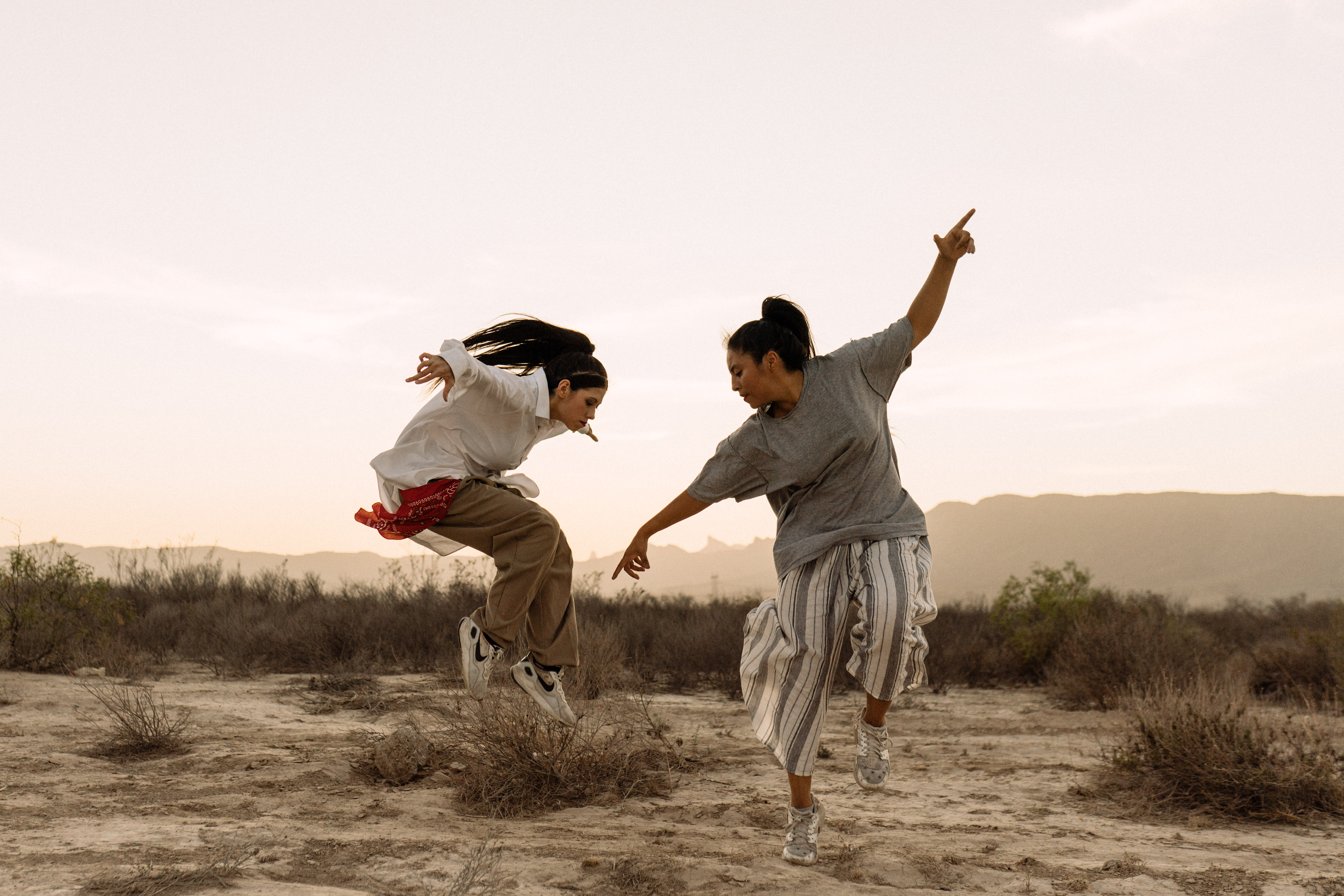
[1] My research was supported by “die Beauftragte der Bundesregierung für Kultur und Medien im Programm NEUSTART KULTUR, [Hilfsprogramm DISTANZEN] des Dachverband Tanz Deutschland and by the Goethe Institut
[2] I use this term instead of “Identity” to refer to something that is not fixed, but in constant movement.
[3] Mestizo as a colonized being that nevertheless recognizes a radical otherness. Rivera Cusicanqui speaks of an explosive and reverberating mestizaje, energized by friction, that impels us to shake and subvert the colonial mandates of parody, submission and silence, to become a decolonized mestizaje.
[4] René Zavaleta on “the variegated”. With this concept he wanted to understand the heterogeneity of our society in all its historical depth.
[5] These adjectives are taken from Rivera Cusicanqui’s description of Ch’ixi entities, they are powerful because they are indeterminate, because they are neither black nor white, they are both at the same time.
[6] This group adopts the name of the capital of Colombia, Bogotá.
[7] This group takes the name of Barranquilla, a city that was the main point of entry to Colombia for thousands of immigrants.
[8] Sonideros play recorded music of so-called tropical genres such as Salsa and different styles of cumbia – with emphasis on Colombian cumbia. The term refers to the disc jockey who plays at social and family parties.
[10] This “colonia” is mostly situated on a hill south of downtown Monterrey. The great player, Celso Piña began his musical career here.
Suggested Citation
Morales, Yolanda. 2022. “My trip to the Cumbia Colombiana in Monterrey“ In: Moving Interventions 2: Between Non-cooperation and Community-building Practices of Resilience in dance – through dance – because of dance, December 2022. Edited by / Herausgegeben von: Sarah Bergh and Sandra Chatterjee, with Ariadne Jacoby (CHAKKARs – Moving Interventions), translated (English to German) by: Anja Tracksdorf (Tracksdorf Translations). eZine published by /veröffentlicht von CHAKKARs – Moving Interventions.
About the author
Yolanda Morales got a diploma in dance in Mexico and did her master’s in performance studies at the University of Hamburg. Since 2016 Yolanda has been working in Hamburg as a choreographer, dancer and performer. In her choreographic works she deals with imaginative bodies in utopian and dystopian spaces that are closely interwoven with current political and social realities. In their production 2666 in co-production with K3 – Center for Choreography | Tanzplan Hamburg reflects on how women* deal with assaults in public space. As part of her project 20 – 21 Street Hamburg, a series of 21 short dance video clips will be created as research and documentation on the subject of women* in public spaces: strategies of resistance. In 2021 she will perform the dance production NERVEN at the Lichthof Theater. Yolanda & Team offers the movement workshops and open rehearsal: MOVING IMAGINATIVE BODIES since 2021 in cooperation with the MARKK – Museum am Rothenbaum. In interactive open dance rehearsals, the participants get insights into the working process of the choreographer. Their productions are invited to festivals in Germany and internationally, including HundertPro in Mülheim an der Ruhr, OUTNOW! FESTIVAL – International Performing Arts Festival in Bremen, Epicentro in Oaxaca (Mexico) and IAPAR International Theater Festival in Pune (India). In March 2023 her new production THE FALLING GARDEN OF SAND will take place at the LICHTHOF Theater Hamburg. Yolanda Morales is currently part of the network Program FREISCHWIMMEN and works currently as a teacher in the contemporary dance school Hamburg (CDSH)
Foto: G2 Baraniak
The research for this article was supported by “die Beauftragte der Bundesregierung für Kultur und Medien im Programm NEUSTART KULTUR, [Hilfsprogramm DISTANZEN] des Dachverband Tanz Deutschland and by the Goethe Institut“


